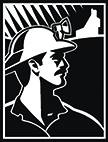
COPPER PROCESSING and STAMP SANDS
Originally a logging launch site, Gay became part of an expanding and profitable copper mining empire when the Wolverine and Mohawk Mining Companies built their mills in Gay, on the shores of Lake Superior.
The Wolverine mine and mill opened around 1900. Within a few years, the Stanton interests from New York, who financed the Central, Atlantic, and Baltic mining companies, added the Mohawk mines and mill and erected housing for the workers at Wolverine, Mohawk, and Gay. They constructed a railroad line to Gay and a dock south of the mill to import coal for power and load copper material bound for the Michigan Smelter on the Portage Canal. By 1902, the entire mine-to-mill operation was in full swing.
Copper processing at Gay was technologically modern. The two mills housed six steam-powered coal-fueled Nordberg stamps to crush rock and separate out copper. Copper-bearing Mohawkite rock, a unique material containing arsenic, was delivered to the top floor of the mill by an elevated rail line. Water was pumped from Lake Superior to move the rock through the mill and produce copper concentrate, then the tailings slurry was expelled back into the lake along a series of ever lengthening conveyors.
Processed by gravity and large amounts of water through steam stamps, the rock was funneled into a trommel that sorted and classified the pieces by size. A jig then separated the copper from the mine rock. The mills had a combined total of 140 jigs. Next, a series of vibrating Wilfley tables separated the tailings from the “middlings” and small sized copper.
Original delineation: Historic American Engineering Record, Heritage Conservation & Recreation Service, Eric M. Hansen, 1978. Modification and rendering: David A. Vago, Michigan Technological University, on behalf of the Houghton County Historical Society, 2005; updated 2021.
Unlike the quiet waters of Torch and Portage Lakes, Lake Superior's powerful waves, currents, and storms made pumping water and expelling waste difficult. The companies built a tunnel several hundred feet beneath Lake Superior to pump water to the mills. They also constructed a concrete slime and heavy log conveyor systems to deposit waste back into the lake.
Caption: 1920 Map of Gay and milling facilities. (1) Water intake tunnel for milling. (2) Pump house. (3) Water line to mills. (4) Mohawk mill. (5) Wolverine mill. (6) Stamp sand conveyor belt. (7) Stamp sand bank. (8) Railroad to Mohawk. (9) Gay School.
Courtesy: Excerpted and modified from US Army Corps 1920 Lake Survey Map of Grand (Big) Traverse Bay, Gay Michigan.
The two mills built a system of launders and belted conveyors to deposit fine (slimes) and coarse sands into Lake Superior. Using water pumped from the intake system at the Tobacco River, they washed the sands as a slurry further and further into the lake as the stamp sand pile grew in size. Remains of the sand conveyor system still mark the Gay shoreline. Photo dated 1907. Courtesy: MTU Archives.



